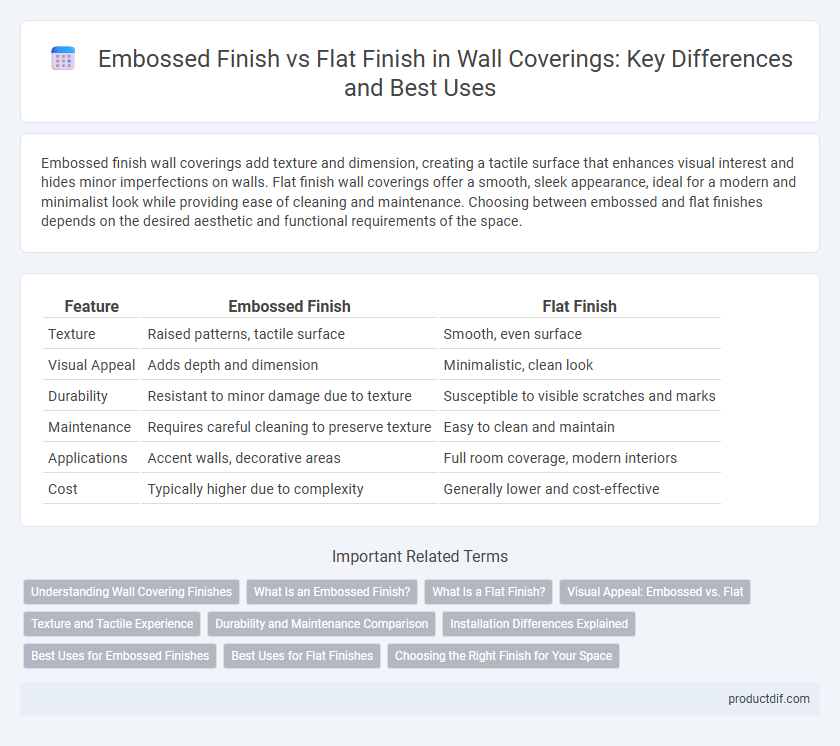Embossed finish wall coverings add texture and dimension, creating a tactile surface that enhances visual interest and hides minor imperfections on walls. Flat finish wall coverings offer a smooth, sleek appearance, ideal for a modern and minimalist look while providing ease of cleaning and maintenance. Choosing between embossed and flat finishes depends on the desired aesthetic and functional requirements of the space.
Table of Comparison
| Feature | Embossed Finish | Flat Finish |
|---|---|---|
| Texture | Raised patterns, tactile surface | Smooth, even surface |
| Visual Appeal | Adds depth and dimension | Minimalistic, clean look |
| Durability | Resistant to minor damage due to texture | Susceptible to visible scratches and marks |
| Maintenance | Requires careful cleaning to preserve texture | Easy to clean and maintain |
| Applications | Accent walls, decorative areas | Full room coverage, modern interiors |
| Cost | Typically higher due to complexity | Generally lower and cost-effective |
Understanding Wall Covering Finishes
Embossed wall coverings feature a raised texture that adds depth and dimension, enhancing room aesthetics through tactile and visual appeal. Flat finishes offer a smooth, uniform surface that reflects light evenly, creating a sleek and modern look ideal for minimalist designs. Choosing between embossed and flat finishes impacts durability, maintenance, and the overall atmosphere of interior spaces.
What Is an Embossed Finish?
An embossed finish in wall coverings features a raised pattern or texture created by pressing designs into the material, providing a three-dimensional effect that adds depth and tactile interest to walls. Unlike a flat finish, which is smooth and uniform, embossed finishes enhance visual appeal and can help mask wall imperfections. This textured finish is commonly used in vinyl wallpaper and specialty papers, offering durability and a rich aesthetic suitable for both residential and commercial interiors.
What Is a Flat Finish?
A flat finish on wall coverings is characterized by a smooth, matte surface that minimizes light reflection, providing a subtle and uniform appearance ideal for hiding imperfections. Unlike embossed finishes, flat finishes lack texture or raised patterns, offering a clean and modern aesthetic. This type of finish is popular in contemporary interior design for creating calm, understated walls that emphasize color depth and simplicity.
Visual Appeal: Embossed vs. Flat
Embossed finishes on wall coverings create a textured, three-dimensional surface that enhances visual depth and adds tactile interest, making spaces feel more dynamic and luxurious. Flat finishes offer a smooth, uniform appearance that reflects light evenly, providing a clean, modern look ideal for minimalist or contemporary designs. Choosing between embossed and flat finishes impacts the perceived richness and character of a room, influencing how light interacts with the walls and the overall ambiance.
Texture and Tactile Experience
Embossed finish wall coverings feature raised patterns that create a textured, three-dimensional surface, enhancing tactile engagement and adding depth to interior spaces. Flat finish wall coverings present a smooth, uniform surface that emphasizes color and pattern without physical texture, offering a sleek and modern feel. The choice between embossed and flat finishes significantly impacts the sensory experience and aesthetic appeal of a room, catering to preferences for either tactile richness or visual simplicity.
Durability and Maintenance Comparison
Embossed finish wall coverings provide enhanced durability due to their textured surface, which can better withstand scratches and dents compared to flat finishes. Maintenance of embossed finishes typically requires more detailed cleaning to remove dust and debris trapped in the crevices, whereas flat finishes offer easier wipe-down and quicker upkeep. Both finishes resist stains and fading, but the embossed texture adds a layer of protection against minor wear and tear in high-traffic areas.
Installation Differences Explained
Embossed finish wall coverings require precise alignment during installation to ensure the raised patterns match seamlessly across panels, often necessitating skilled labor and extra time. Flat finish wall coverings offer easier installation with minimal pattern matching, allowing for quicker application and reduced risk of visible seams. Proper surface preparation is critical for both types, but embossed finishes may demand more careful adhesion techniques to maintain texture integrity.
Best Uses for Embossed Finishes
Embossed finishes on wall coverings create texture by raising patterns or designs, making them ideal for hiding imperfections and adding depth to living rooms, dining areas, and feature walls. This finish enhances visual interest in high-traffic spaces while providing durability and a sophisticated look. Embossed wall coverings are also well-suited for rooms requiring tactile appeal, such as bedrooms and offices.
Best Uses for Flat Finishes
Flat finishes are ideal for walls with imperfections as they effectively hide surface irregularities and provide a smooth, non-reflective appearance. These finishes work best in low-traffic areas such as bedrooms or adult living spaces where touch-ups are infrequent. They also offer a classic, elegant look that complements traditional and modern interior designs without drawing attention to wall texture.
Choosing the Right Finish for Your Space
Embossed finishes provide texture and depth to walls, enhancing visual interest and creating a tactile experience ideal for accent walls or spaces needing character. Flat finishes offer a smooth, sleek appearance that reflects less light, making them perfect for ceilings or rooms where a subtle, clean look is desired. Consider room function, lighting conditions, and desired ambiance when selecting between embossed and flat wall coverings to achieve optimal aesthetic and practical results.
Embossed Finish vs Flat Finish Infographic

 productdif.com
productdif.com